How to make your own Sourdough Starter, using simple ingredients with no special equipment, in just six days, that can be used in our sourdough bread. Video.
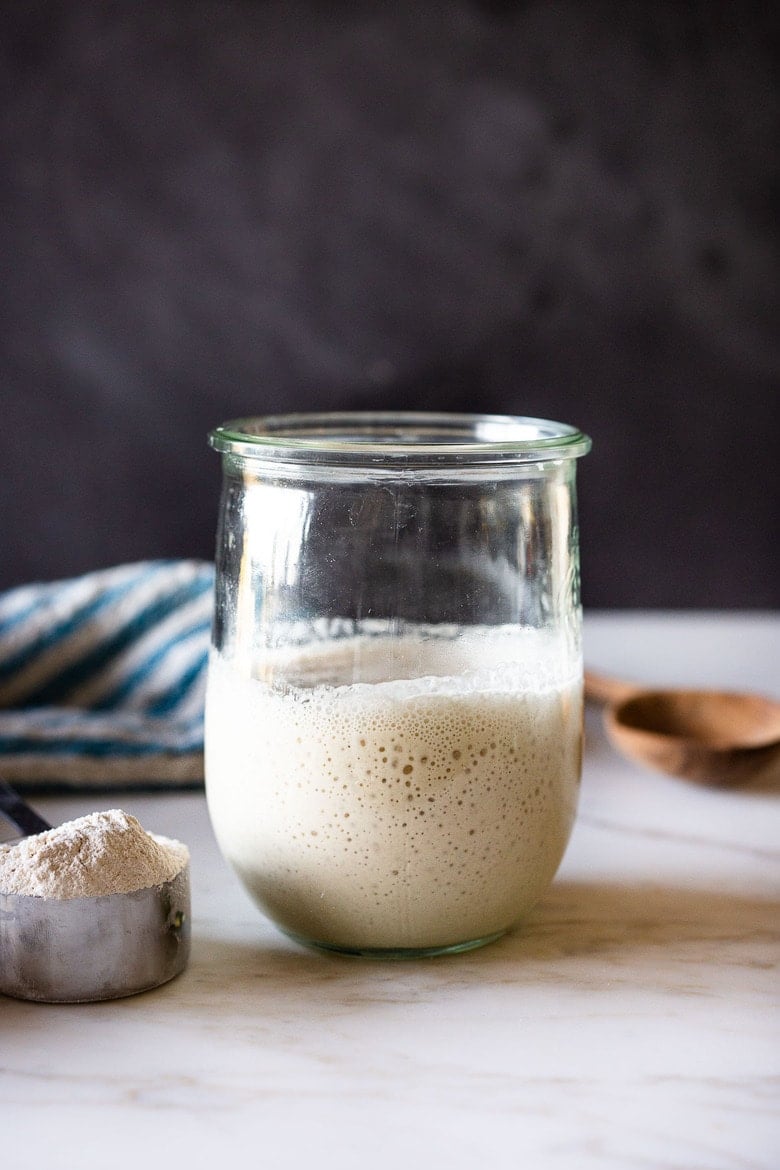
When you understand one thing through and through, you understand everything.~ Shunryu Suzuki
With over 500 five-star reviews and hundreds of success stories, my chef’s perfected sourdough starter guide has everything you need to make your own homemade starter. In just six days, you’ll be baking the most beautiful sourdough loaves!
But first, What is a starter?
Sourdough starter is a “wild yeast” made from flour, water, and the natural wild yeast in the air. With a little care and patience, it ferments, and when strong and active, just a little bit of starter replaces commercial yeast and makes your bread rise, while transforming the gluten in the bread into something more easily digestible. Store-bought yeast is not needed!
How to Make Sourdough Starter | 20-Min Video
***Don’t see the video? Allow 15-20 seconds to load it right here!*** (Still don’t see it? Check that your ad blocker is turned off; use Chrome for the best experience.)
Fast forward to Specific Day by video time (using scroll bar underneath video)
- Day 1 Morning: :23
- Day 2 Morning: 4:10
- Day 3 Morning: 7:00
- Day 3 Evening: 9:12
- Day 4 Morning: 11:50
- Day 4 Evening: 13:37
- Day 5 Morning: 14:45
- Day 6 Evening: 16:50
- Day 6 Morning: 18:12
- Day 6 Evening: 20:10
Sourdough Starter Recipe Ingredients
- Jar – A wide-mouth quart jar or a Weck’s 1-liter tulip jar.
- Flour – 5 lb bag of organic bread flour (plus 1 cup organic whole grain flour )
- Water – filtered water, tap water, or mineral water (specifically, San Pellegrino, for the correct mineral ratio). Distilled water does not have enough minerals.
- Scale – using a kitchen scale is optional but handy.
- Thermometer – Knowing the temp of the starter using a thermometer is optional but handy!
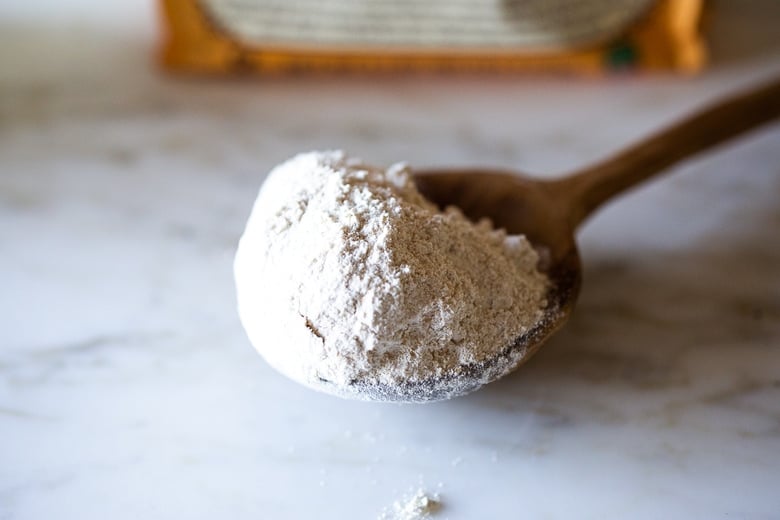
Understanding starter
- Think of sourdough starter as yeast. Only in this case, instead of buying a packet of yeast from the store, you are making your own living “wild yeast” by fermenting flour and water. Once it’s bubbly and happy, it is very much ike a very low-maintenance pet.
- You must feed it (stir in a mixture of flour and water) once a week to keep it active and strong. You know it’s happy when it bubbles. 😉 And YES, you can even name it.
- Some people believe that bread made with sourdough starter is actually better for you than bread made with yeast. Here and Here are a few articles to get you started on your own research. While I’m not sure if this is scientifically proven, I do know that bread made with sourdough starter, tastes infinitely better, feels easier to digest, and has more complexity and better texture, than bread made with commercial yeast. So if you are a bread lover- this is absolutely the way to go, as far as the quality of your finished bread.
How to Make Sourdough Starter
*See the recipe card for detailed instructions.
This recipe for Sourdough Starter takes 6 days (or up to 12 days if it is very cold where you live). For a primer, watch the 20-minute Sourdough Video above!
Day 1: Staring in the morning or at night, using a wide-mouth quart jar, tulip jar, or Crock or Glass Measuring Cup , mix 1 cup whole grain flour (120 grams) with 1/2 cup filtered water (120 grams) using a fork (or chopstick) making sure you’ve incorporated all the dry flour.
Place the lid lightly on top (using the Weck jar lid is really handy here) or a wet towel to keep moisture in, or plastic wrap- and let sit at room temperature (70-ish degrees) on the kitchen counter for 24-48 hours. If you are unsure how warm it is, use a kitchen thermometer and check it a few hours later. See notes for TEMPERATURE.
TIP #1: For your first measurement, weigh the flour using a kitchen scale so you can get an idea of how the mixture should feel. Do not weigh the measuring cup! It should be like a thick paste, like peanut butter. If you need to add a little more water to incorporate the flour, that is OK too!
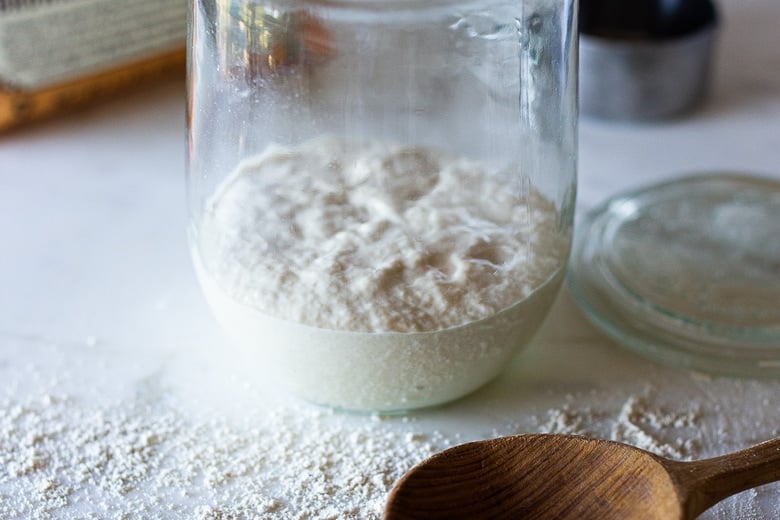
Day 2: After the first 24 hours, there may or may not be a bit of bubbling. Let the mixture rest until you see activity (bubbles or rising) sometimes this takes 36 hours or even 48 hours if very cold. When you see active bubbling, discard all but 1/2 cup of the starter (4 ounces).
To the remaining ½ cup of starter, stir in 1/2 cup water (120 grams), and mix well with a fork. Add 1 cup of organic bread flour (120 grams)spooned and leveled. Stir until combined. Again, it should feel like a thick paste. If overly dry, feel free to add a bit more water. Cover again and allow the mixture to sit at room temperature for another 24 hours.
Day 3: After 24 hours, hopefully, you will see some bubbling or rising and if not, let it go a bit longer until you see activity. Be patient.
Depending on how warm your house is and how active your starter, you may need to begin feeding more often or move to two feedings a day, in the morning and at night. If it is cold, one feeding a day may be enough.
TIP #2: Only feed the starter after it has peaked or looks hungry. See the “3 Signs of Hunger” below. Feeding it when it is “not hungry” will basically dilute all the growing yeast and make it lethargic. Better to underfeed than overfeed.
The 3 Signs of hunger
The photo below was taken after the starter was fed, and after it peaked (reached its highest), and now is sliding down. It is now “hungry” again. See the downward slide marks on the jar? Pay attention – your starter is telling you it is hungry.
- Look for “slide marks” (be sure to use a clean jar so you can see these clearly).
- Liquid at the top of the starter.
- Thin and runny. The starter is liquidy enough to pour out of the jar (when at room temp).

This might be 12 hours, it might be 14, it might be 18, or 24, depending on the temp in your house. In very warm climates, it may only be 6-8 hours. In winter, this may take 36 hours. It is better to underfeed rather than overfeed here.
For each feeding, discard all but 1/2 cup of the starter (keeping roughly ½-cup of starter in the jar). Add 1/2 cup water and 1 cup Bread Flour (spooned and leveled). Mix well, cover, and let this rest at room temperature for 12-24 hours or until the starter looks “hungry” again before repeating.
Day 4: Feed 1-2 times, discarding all but 1/2 cup of starter each time. Feed 1 cup bread flour, 1/2 cup water.
TIP #3: It is typical on day 4 for the starter to slow down and stall a bit. This is OK. Just keep going, be patient and look for the hunger signs, and only feed when clearly hungry. Hopefully, you’ll begin to see some rising and falling. It’s helpful to put the starter in a clean jar each day and mark the beginning level (with a sharpie, string or rubber band) so you can easily see this.
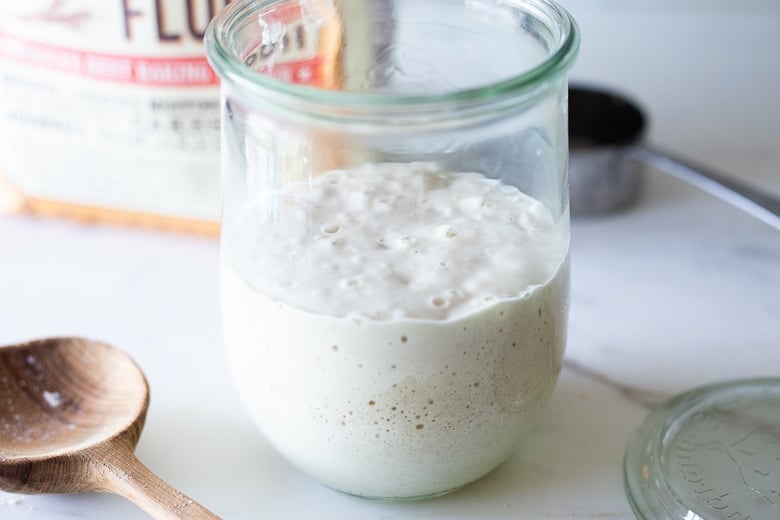
Above, you’ll see it peaking, and below, you’ll see it deflating and getting “hungry.” There may not be too much difference in the beginning, so look closely.
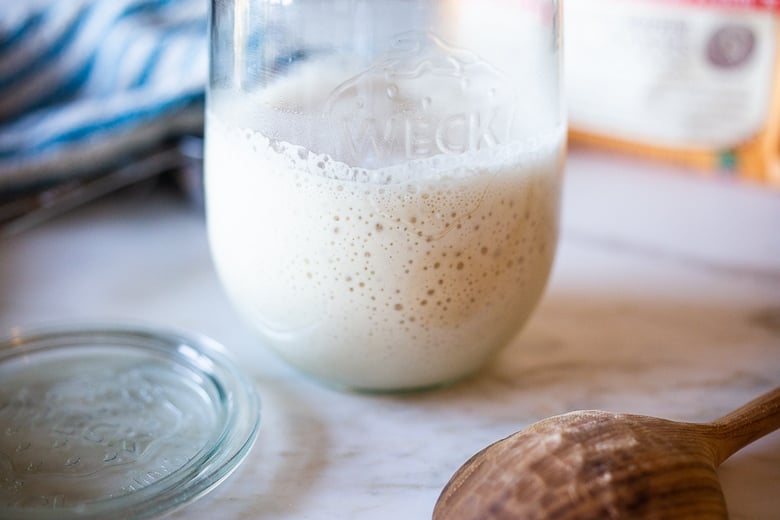
Understand that your starter has a schedule of its own; it is a living thing, so watch it and pay attention.
If your starter is not rising and falling, look at its consistency. As it metabolizes the flour and gets hungry, it will get runny and liquidy, like to the point where you can pour it right out of the jar. If it is still thick like paste, it’s not done metabolizing (eating)the flour.
Day 5: Feed again, 1-2 times, discarding all but a 1/2 cup the starter each time. Adding 1 cup bread flour and 1/2 cup lukewarm water. The starter should look visibly active, bubbling, rising, hopefully, close to doubling in size.
Repeat day 5 until the starter is rising and falling predictably and is close to doubling in size within 6-8 hours.
TIP #4: If your starter is not rising but there is evidence of hunger (liquidy or liquid at the top) try 3 things: substitute 1/4 cup whole grain flour (add to ¾ cup white bread flour) on your next feeding. Try using mineral water like San Pellegrino instead of water. Stir the starter a few times after feeding to allow more wild yeast from the kithcen to get inside.
DAY 6 Morning: Baking day! Give it one last feeding in the morning: this time discard all but a 1/3 cup. (The reason we are changing this to 1/3 cup is to feed it a little bit more.) Add 1 cup flour (120 grams) and 1/2 cup water, stir, and place it in a clean jar so you can see the action clearly. You can use a sharpie or place a rubber band around the jar to mark the beginning level. The starter should hopefully double in volume within 6-8 hours of feeding.
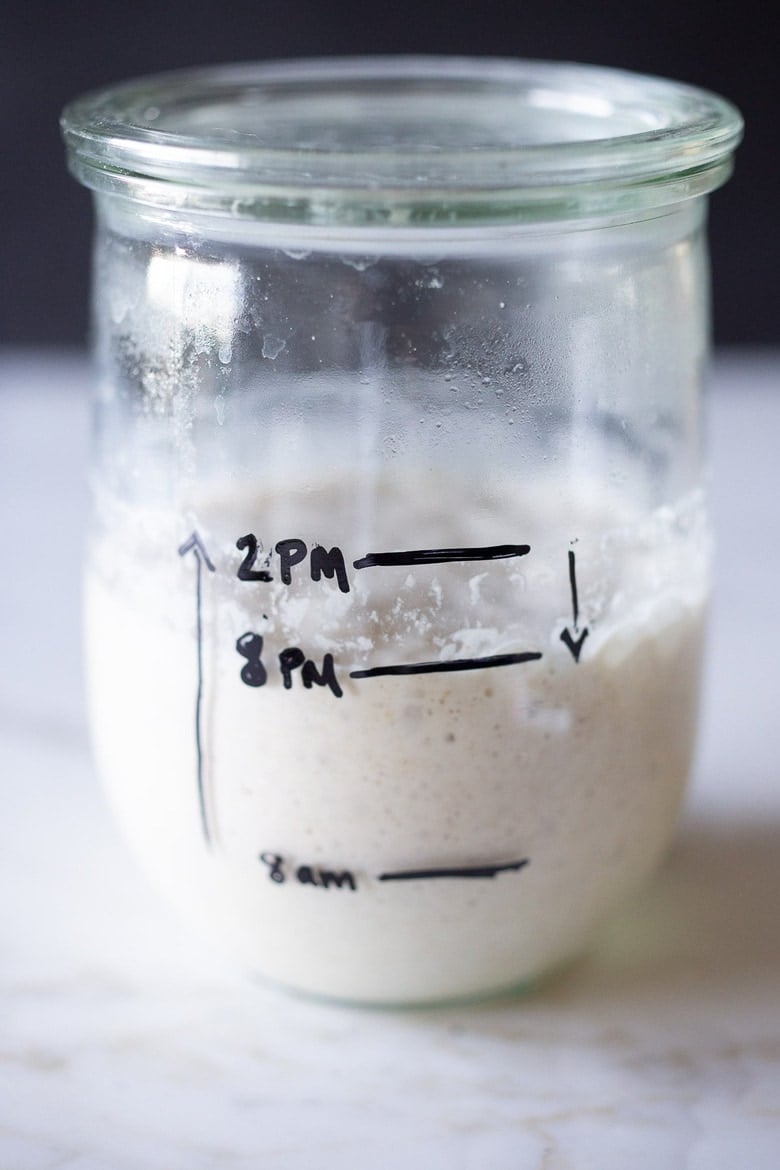
In the photo above, on the 6th day, the starter was fed at 8 am, it peaked around 2 pm, then it started deflating, and by 8 pm, it was “hungry” again. See those downward “slide” marks on the jar?
DO THE FLOAT TEST: When the starter is at its peak, or just after, place a teaspoon of starter (just from the top, don’t stir it down) in a glass full of water; it should hopefully float. If it floats, success!!! Congrats. You can now make our sourdough bread…tonight!
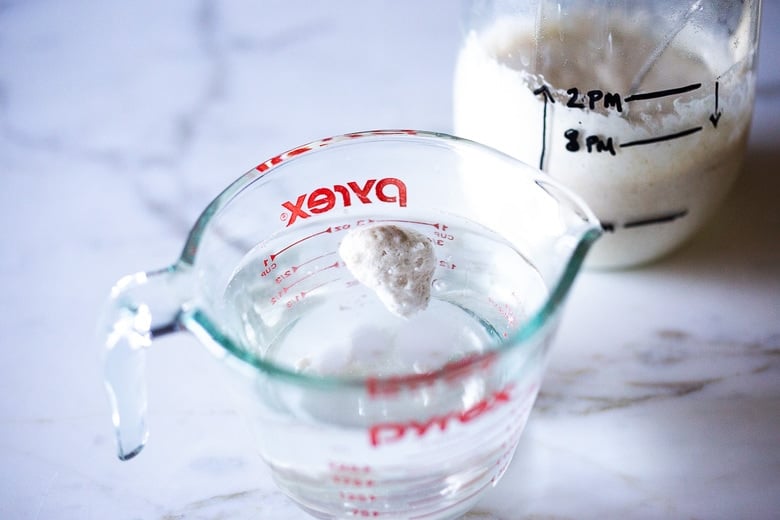
TIP #5: When baking bread always use hungry starter that has already peaked!
STARTER DOES NOT FLOAT? If it doubles in size but does not float, you can still try baking a loaf if it doubles within 6-8 hours of feeding it.
At this point, if your starter does not double in size within 6-8 hours of feeding, don’t give up! Often, it just takes longer, especially during the winter months. Continue feeding one to two times a day until you see a consistent, predictable rise and fall.
Read the troubleshooting section. If you need to take a break, put it in the fridge and try it again up to a week later. Don’t toss it!
Day 6 Evening: Let’s Bake! Use 1/3 cup starter to make this sourdough bread recipe and place the remaining starter (or if not making bread, place all of it) in the refrigerator, and feed it at least once a week, reserving ½ cup starter, before feeding it the usual 1 cup bread flour, 1/2 cup water.
TROUBLESHOOTING Starter
- SMELL: Starter should smell sweet, tangy, earthy, like a wet horse – not “bad”. If it really smells foul or unpleasant, you may have used an unclean jar, unclean utensil, or somehow introduced other bad bacteria. I would start over.
- NO ACTION: On day 4-5 it is typically for it to slow down. If your starter is not rising at all but there is evidence of hunger (liquid at the top, or bubbles) try 3 things. First substitute 1/4 cup whole grain flour (add to ¾ cup white bread flour) on your next feeding. If no rise, then try using mineral water, specifically San Pellegrino instead of water. San Pelligrino specifically has the right mineral ratio, I have great luck with it. Others not so much! Also try stirring the starter a couple of hours after feeding, a couple of times throughout the day to allow wild yeast from the room to get in there. Lastly, you could try pineapple juice instead of water.
- FLOUR: Try to use fresh milled whole grain flour to start, then organic BREAD FLOUR. The more wild yeast in the flour, the better your starter will do- so smaller brands like Bob’s Red Mill seem to do better than bigger conventional brands that have been overly processed. It is totally OK to mix flours and to switch them up- this adds different kinds of wild yeast- a good thing!
- DO NOT overfeed. For example, maybe feeding 2 x day at 12-hour intervals is too often. You want to feed after the starter has peaked, then deflated (see photo above- you’ll see some slide marks on the jar) and this tells you that it is hungry. If you feed the starter before it has had a chance to metabolize (or eat) all the flour (before peaking) and then you discard part of it, and feed it again, you are actually diluting all that amazing bacteria, weakening your starter. So it’s all about watching your starter in your home. If you are not seeing rising and falling, but notice the starter just gets liquidy, this too is a sign of “hunger”. Or if it gets runny enough to pour out of the jar, another sign it is hungry. There are lots of variables here. Just be patient, pay attention and watch. This is a living thing- it doesn’t care about time schedules and recipes or what it “should” do. It will “eat” when it is “hungry” and sometimes it likes to eat slowly. 😉
- TIME: It may take longer than 6 days in colder environments. Use a kitchen thermometer and take its temp. Is it over 65F? Find a place where it can be warm. In the oven with the light on, or in an upper cupboard ( heat rises). Sometimes it takes 12-14 days! Be patient, keep going. If it is doing absolutely nothing, leave it out on the counter for 24-48 hours and see what happens. If you run out of flour or need a break, don’t just toss it, put it in the fridge and see if you can get it going a few days later.
- ACIDITY: If you still can’t get that starter going, some people recommend subbing pineapple juice for the water for one feeding- raising the acidity level. My good friend just tried this and it got hers going.
- LIQUID: If you see any liquid at the top of your starter, it means your starter is hungry. So, yes it’s still alive which is a good thing! You can stir the liquid in, or pour the liquid out, either way, but feed it. This is a sign that you may need to feed it more often.
- MOLD: if you see any discoloring or mold on the surface, starter was probably contaminated. If it is only on the surface, it is probably ok to save. Scrape it off, save 1/2 cup of the underneath starter, and keep going, using a clean jar. Feed, smell, use your best judgment.
- FLOAT TEST: Try testing when your starter is peaking. Take a spoonful from the top without stirring it down. If your starter is rising and falling consistently, but not passing the float test and it has been over 8-10 days- just try baking a loaf. People are having luck with good loaves without passing the float test. It may be the flour…
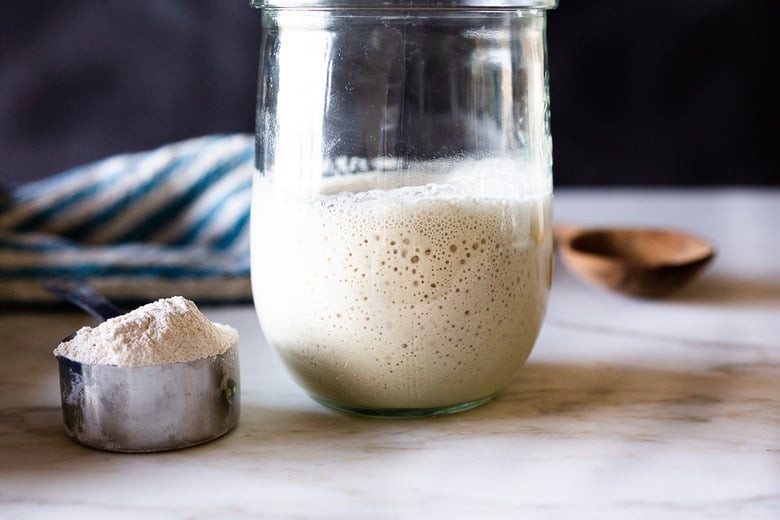
How to Maintain Your Starter
- REFRIGERATE & FEED AT LEAST ONCE A WEEK: Pick a scheduled day and try to stick with it, always reserving 1/2 cup and feeding it 1 cup flour and 1/2 cup water. Discard the remaining, give it away, or keep the discard in a separate container for sourdough pancakes, sourdough buns, banana bread, biscuits, etc. I usually don’t feed the discard unless I give it away.
- If you forget to feed it one week, it is most likely OK; feed it 1-2 times a day for 1-3 days in a row to revive it (keeping it out on the counter) until bubbly and active and doubles within 6 hours. I’ve left my starter for a month on vacation (in the fridge) without feeding and simply revived it by feeding it 3 days in a row, 1-2 x day. It’s surprisingly hard to kill. You can also freeze it for more extended storage.
- This batch will allow you to bake 2 loaves of bread per week with enough left to feed for the next week. If you want to bake more often, you can keep it out and feed it 1-2 x daily. Or if baking every few days, you can pull it out of the fridge, feed it 10 hours before using, leaving it out, use what you need while it is peaking (or slightly after), then put it back in the fridge that evening. Do the same thing a few days later when ready to use again. So this would be feeding 2-3 times a week, best if baking 4-5 times a week.
The best time to use sourdough starter is just after it peaks or on its way down when you know it is hungry.
Sourdough Bread Starter FAQs
Yes. While you are building your starter, during the first week, it is the simplest, easiest, fastest, and most economical way to create a healthy starter. (Or save it separately -in the fridge- and use it in Pancakes, Waffles, Buns, or Biscuits. ) This is because you always have to feed it two times its volume in flour. For example-if you kept all the 1 1/2 cups of starter, you would have to feed it 3 cups of flour (instead of keeping just a 1/2 cup and only feeding it ONE cup). Discarding will shorten the fermentation process, require less flour in the long run, and create a stronger starter. Once your starter is “established” after the first week- then you can give it away to friends, use it in pizza dough, pancakes, etc) or give it to a friend.
How to use your Sourdough Starter
- See all our Sourdough Recipes!
- Sourdough Scones
- Sourdough Crackers
- Sourdough Biscuits
- Sourdough Buns
- Sourdough Tortillas!
- Vegan Banana Bread
- Overnight Sourdough Waffles
More from Feasting At Home
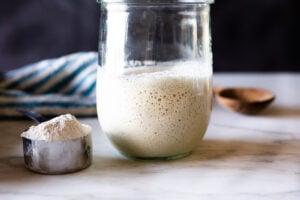
Simple Sourdough Starter
- Prep Time: 30
- Cook Time: 6 days
- Total Time: 144 hours 30 minutes
- Yield: 1 ½ cups
- Category: sourdough, fermented, cultured, bread, baking,
- Method: fermented
- Cuisine: bread
- Diet: Vegan
Description
How to make your own Sourdough Starter (see the step-by-step video in post) using simple ingredients with no special equipment, in 6 days, that can be used in sourdough bread. Sourdough Starter is a wild yeast, made from fermenting flour and water.
Ingredients
- 120 grams whole grain flour (whole wheat flour, rye flour, or freshly milled flour) 1 cup, fluffed, spooned and leveled
- Organic White Bread Flour (5-10 lb bag ) I like Shepherd’s Grain or Bob’s Red Mill.
- 120 grams Water per feeding (1/2 cup water)
Instructions
-
- Day 1: Starting in the morning or at night, using a wide-mouth quart jar or Crock or Glass Measuring Cup mix 1 cup whole grain flour (120 grams) with 1/2 cup (120 grams) filtered water using a fork making sure you’ve incorporated all the dry flour. For your first measuring – it is a good idea to weigh the flour, using a kitchen scale so you get an idea of how thick it should feel. It should be like a thick paste. Thick like peanut butter. If you need to add a little more water to incorporate the flour, that is OK, but be precise with the flour. Place the lid on top (using the Weck jar is really handy here) or a damp towel to keep moisture in, or plastic wrap- and let sit at room temperature (70-80 degrees) on the kitchen counter for 24-48 hours, or until you see some bubbling. If you are not sure how warm it is, use a kitchen thermometer and check it a few hours later. See notes for TEMPERATURE.
- Day 2: After the first 24 hours, you may or may not see a bit of bubbling. I prefer to let this rest until I see a tiny bit of activity (bubbles) and sometimes this takes 36 or up to 48 hours. So start “day 2”, when you see a little bit of bubbing. Discard all but 1/2 cup (136 grams) of the starter. (See notes for discard). Add to the remainder, 1 cup of white bread flour, (120 grams), spooned and leveled, and 1/2 cup filtered water (120 grams), mixing well with a fork. Place the lid on loosely again and allow the mixture to sit at room temperature (70-80F) for another 24 hours.
- Day 3: By the third day, you should definitely see some bubbling- and if not, let it go a bit longer. Depending on how warm your house is and how active your starter, you may need to begin feeding more often, or even move to two feedings a day roughly 12 hours apart, like in the morning and at night. In a nutshell, you want to feed the starter only after it has peaked (metabolized all the flour from the last feeding) and has started sinking down or gets liquidy- this is when it is hungry! This might be 12 hours, it might be 14, it might be 18, or 24, depending on the temp in your house. In very warm climates it may only be 8 hours. It is better to underfeed rather than overfeed here. For each feeding, like before, discard all but 1/2 cup of the STARTER (keeping roughly ½-cup of starter in the jar -4 ounces or 136 grams) Add 1 cup Bread Flour (spooned and leveled) and 1/2 cup water to the 1/2 cup starter and let this rest at room temperature for 12-24 hours or until the starter looks “hungry” again before repeating.
- Day 4: Feed 1-2 times, discarding all but 1/2 cup of starter EACH TIME. Feed 1 cup bread flour, 1/2 cup water. Look for the hunger signs. Hopefully, you’ll begin to see some rising and falling. It’s helpful to put the starter in a clean jar and mark the beginning level (with sharpie, string or rubber band) so you can easily see this. ***If for some reason your starter looks like it is still rising at the time of second feeding (at night) and there is no evidence it has fallen or no slide marks, it is still “eating” so skip this feeding and feed first thing in the morning. AGAIN, Feeding it when it is “not hungry” will basically dilute all the growing yeast and make it lethargic. Better to starve than overfeed.
- Day 5: Feed again, 1-2 times, roughly 12 hours apart, or when hungry, discarding all but a 1/2 cup the starter EACH TIME. 1 cup bread flour, 1/2 cup lukewarm water. The starter should look active, bubbling, rising, sliding down, hopefully, close to doubling in size. (If not, repeat this day until starter doubles in size within 8-12 hours of feeding- and read the troubleshooting section.)
- DAY 6: Give it one last feeding. Discard all but a 1/3 cup. Add 1 cup flour ( 120 grams) and 1/2 cup water, and place it in a clean jar so you can see the action clearly. You can use a sharpie or place a rubber band around the jar to mark the beginning level. The starter should hopefully double in volume within 6 hours of feeding. When it peaks, DO THE FLOAT TEST: To test the starter, place a teaspoon of starter (just from the top, while it is peaking, don’t stir it down) in a glass full of water, it should hopefully float. If it does, you can make sourdough bread. Tonight! Let the starter keep resting at room temperature or a few more hours allowing it to fully metabolize the flour, perhaps sinking a little before making your dough. You want to make dough with slightly hungry starter. Place the remaining starter in the fridge and feed it in a week. You’ll have enough stater to make one more sourdough loaf during the week, and still have enough to feed. If you want to wait to make bread until later in the week place starter in the fridge. Be sure to feed it in 7 days. Read maintenance section.
- At this point, if your starter does not double in size don’t give up! Often it just takes longer, sometimes up to two weeks, especially if it’s cold. Continue feeding one-two times a day (only when hungry) for a few more days, until you see a visible rise and fall. Read the troubleshooting section. If you need to take a break, just put it in the fridge and try it again up to a week later. Don’t toss it- if there are bubbles, it is still alive.
- This batch of starter will make two loaves of bread with enough left over to feed for the following week.
Notes
- TEMPERATURE: The colder your home, the longer it will take for the starter to grow and become active (bubbles). Find a warm spot (70-80 degrees) for the best results. On the stovetop, with the light turned on, or on top of the fridge. Or in the oven with the light on. On top of a heating pad (set to low) with a towel in between). You can still make the starter in a colder home, it will just take longer- even up to 2 weeks.
- FLOUR: Always try to start the batch by using organic, freshly milled whole-grain flour (wheat or rye) because it has more wild yeast in it than All-Purpose or white flour and will get it active and growing sooner. You can, of course, continue to use whole grain, but I’ve had the best luck using organic “bread” flour for days 2 through 6. People have made a sourdough starter with All-Purpose flour- but personally, this has never worked for me– there are fewer nutrients and wild yeasts in the flour and results in a very lethargic starter. If it is your only option, try mixing in 2+ tablespoons of whole-grain (wheat or rye) with the AP flour per feeding. Feel free to use different flours or mix different flours together. It is OK to use all-purpose flour if in a pinch, but using it repeatedly will result in sad starter.
- WATER: I usually use tap water -but sometimes the chlorine in tap water can inhibit the growth of your starter. Lukewarm water helps fermentation to start faster. Sterilized bottled water is often overly sterile, and can also inhibit. Mineral water, like Perrier (carbonated is OK) can sometimes work miracles.
- HYDRATION: Hydration refers to the ratio of water to flour in terms of weight. It is a ratio. The starter is typically at 100% hydration- meaning equal parts flour and water, in terms of weight. So if you use 120 grams of water, use 120 grams of flour. This roughly translates to 1 cup of flour and 1/2 cup water. Feel free to weigh instead of measure if you want to be more precise, or want to familiarize yourself with the consistency you are aiming for. If using whole grain flours (which tend to be “thirstier”) and your starter seems very thick, it is totally OK to add more water to thin it a bit. I intentionally keep the hydration a little lower here (a thicker starter) so you can more clearly see the rise and fall “action” in the jar.
- STORING AND FEEDING: When your starter is kept cold, in the fridge, you don’t need to feed it as often- only once a week. Feel free to feed it “cold”, and put it right back in the fridge if you like. If you keep it out on the counter, you’ll likely need to feed it 1-2 x daily (or just watch and feed only when hungry). Cold slows down the fermentation, heat speeds it up.
- USING: When you need to use your starter for baking bread, feed it 10-12 hours before making bread dough, using it after its peak height. For a more “sour” flavored bread, use the starter straight from the fridge, 3-6 days after feeding. The starter gets more sour tasting the longer it goes without feeding. Feeding the starter the same day as making bread will produce a milder sourdough flavor.
Nutrition
- Serving Size: 1 tablespoon
- Calories: 31
- Sugar: 0 g
- Sodium: 0.2 mg
- Fat: 0.1 g
- Saturated Fat: 0 g
- Trans Fat:
- Carbohydrates: 6.2 g
- Fiber: 0.2 g
- Protein: 1 g
- Cholesterol: 0 mg
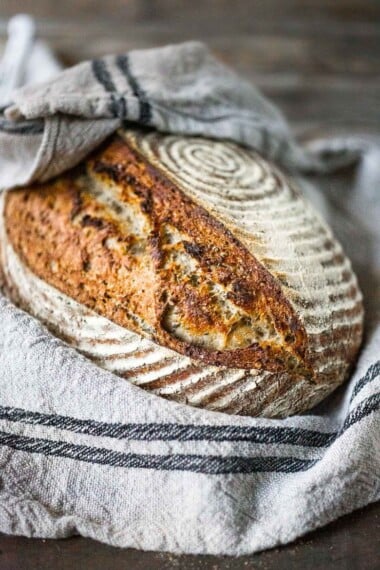

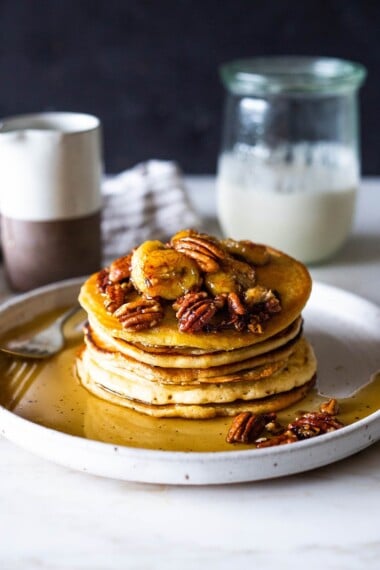
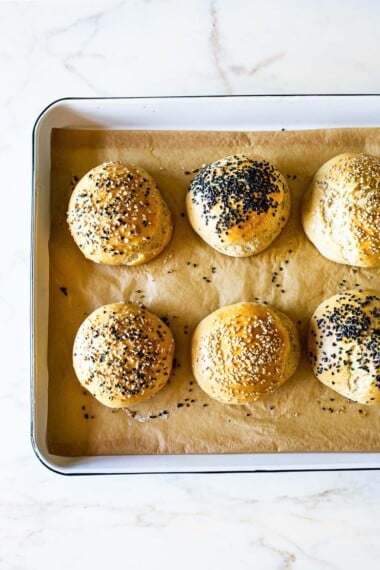







Ms. Sylvia-
Thanks for the guidance and help, but I have run into another slow patch. In the beginning it was very active (day 2-3) and tripled in size. Then the peak/slide became substantially less (maybe 1/4 inch), and now it looks like it’s not rising or falling. The top does still have bubbles and its in a room in the low 70’s. Our last feeding we tried whole wheat flour (12 hours ago), but still no change in size. There are bubbles on the top though. There is no clear liquid on top. When I’ve fed it and stirred it before placing it in the jar it is the consistency of a very thick/sticky batter. When we take it out of the jar to feed it seems to be the consistency of pancake batter. Not really sure what to do. What would you recommend? Thanks again.
Hi Jon, so bubbles and pancake batter means it is processing and getting hungry. So that is good. It is definitely alive. Why don’t you just let it get really really hungry, before feeding the next time. Like let it go 24 hours? Weigh the flour. Use filtered water. Try a mix of white and wheat? Let me know what happens.
seems to have worked !! thanks. We’re now on day 7. Quick float test question.
It did float this morning, but it looked as if it was slightly falling apart. There was a main “glob” that stayed together but some pieces frayed. does this mean it has passed, or should we wait? It is still a little liquidy. What consistency am I looking for?
thanks !
I think it has passed. 🙂 If it feels liquidy it is probably hungry.
Hi Sylvia,
I think I finally succeeded. I was doing starter with all purpose flour and it was not quite doubling in size. Now, for the past half a week I have been feeding it with half rye and half all purpose flour and my starter has been doubling great and it’s floating. I just started the bread and feeling so excited.
Should I continue feeding it with half and half mixture of rye and all purpose or just all purpose? Those are the only flours I can find now.
If I ever freeze my started how do I treat it after throwing? Thanks
Great! You know… I would use mostly AP flour but with a couple of tablespoons rye mixed in. AP flour has very little “nutrients” to keep it healthy.
After thawing, leave it out a few days feeding as needed until it is strong again.
Thanks a lot, Sylvia!
Love this recipe! I was able to make one load of bread so far. Now I’m ready for my second loaf, but after taking my starter out and feeding it, I’m not seeing any growth. What should I do? It’s been about 24 hours.
How long was it in the fridge without feeding?
About 5 days
Theoretically, it should work without feeding it. But since you’ve fed it, just let it go till it looks hungry again and perhaps feed it once more, in the morning and make dough at night.
There is one little detail that I just can’t seem to quite understand.What does the rhythm and maintence look like? Once the starter is established and placed in the fridge, once a week you pull it out and discard all but 1/2 cup and feed? Then make dough 4-8 hrs later after peaking with 1/3 cup and place remaining starter in the fridge. Why throw away the part of the starter? Why not feed it and use to make bread? Can you take out enough of peaked starter (make 2 loaves) so that there is only 1/2 cup left to refrigerate and then none to throw out at the next feeding? Just trying to get a feel for how rhythm of looking after it looks like when baking once a week.
Christina- you can use the “discard” in other recipes ( waffles, pancakes, scones, biscuits, pizza dough) or give it away to friends. If you keep it and feed it you will end up multiplying it and having a LOT to manage and feed. Which is fine too – if you bake bread a lot.
I’ve made 3 loaves so far with your recipe and we are delighted! I do have a couple of questions – my bread burns a bit on the bottom, but the rest of the loaf is perfect. Also, the bread is very moist and dense – is that how is is supposed to be? I do check the temperature and have had to leave it in about 5 minutes longer. Thanks!!!
I’m wondering if it is slightly under proofed? It really shouldn’t be too moist or dense. Perhaps try letting rise a little longer? Also place a sheet pan under the dutch oven (don’t preheat it) or try lowering heat to 475 F, adding a few extra minutes.
Loved the video! My starter, Audrey, (“feed me”) is going strong going on 3 weeks now. We’ve been enjoying sourdough sandwich bread, with a fresh loaf every few days. I appreciate the simple measure and mix method you presented; takes the pressure off with all the exact weighing and whatnot. Thank you! I expect Audrey to be a part of the family for years to come.
Congrats Dianne!!!
Feed me Seymore! I looooove it! I may just steal this name
🥰🥖
Hi, when my starter is ready and active can I use it a few days later if so should I refrigerator it until I’m ready and then feed it a few hours before I make my bread? Or should I continue my two feedings a day and leave it out until I’m ready to bake?
If you need to conserve flour, refrigerate until using (no need to feed first). Or you can continue to strengthen it by feeding it on the counter but only when it looks hungry.
Thank you so VERY much for posting this help on making the excellent bread! I’ve been wanting to do this for years and now had the time to try, but I wouldn’t have been brave enough without your detailed directions and videos!! The 1st loaves (with nuts and cranraisins) came out beautifully, and I can rate it as one of the best breads I’ve ever had! (for 35 years I’ve always made yeast breads, which are fine, but this is what we really like!)
The recipes for the discard are great too! My husband absolutely LOVED the scones! Thanks for posting this!!
Yay Carol! Thanks so much! My husband loves the scones too.
Thank you so VERY much for posting this help on making the excellent bread! I’ve been wanting to do this for years and now had the time to try, but I wouldn’t have been brave enough without your detailed directions and videos!! The 1st loaves (with nuts and cranraisins) came out beautifully, and I can rate it as one of the best breads I’ve ever had! (for 35 years I’ve always made yeast breads, which are fine, but this is what we really like!)
The recipes for the discard are great too! My husband absolutely LOVED the scones! Thanks again for the help!!
Ms Sylvia, My first time making sour dough, I love and thank you for sharing Yesterday was day 3 I fed at 7:30 am and dough rose but even by 8 pm it had not peaked, I fed it at 8:30 pm with no slides, and this morning it is rising well lots of bubbles, but it has not peaked or slides, I’m worried how to get 2 feedings in a 24 hr or even 36 hr period? Do I just wait till it peaks then feed it regardless of days? and when it passes float test it is ready.? thanks for any help
Yes, just feed according to your what your starter shows you. Don’t worry about the schedule. It may be colder there.
what if i do not get in 2 feedings per day? so sorry to be pest
You are not a pest! Just feed it when it looks hungry. 🙂
When you feed the starter once a week, do you Put it back in the fridge straight after or do you let it rise and sink and then put it in the fridge?
I usually just put it back in the fridge. Some people say to let it peak beforehand- there is some debate. 🙂
Hi Sylvia, I have made my dough but my timing is off. According to your amazing instructions, I would have to get up in the middle of the night to make my bread. Can I put the dough in the refrigerator and then bring it to room temperature in the morning? Thanks for your wonderful tutorials.
Give it a try. It may proof a little in your fridge depending on your fridge temp, so just really watch it after you pull it out. It may need 6 more hours, 8 hours, I have no idea – so just watch it and take notes, so you can perfect it for the next time.
I’m going to use spelt flour. (My family and I are following “The Maker’s Diet.” Can I do 1/4 cup of starter each time? (60g spelt/60g water?) Also, can I do spelt instead of bread flour?
Yes, feel free to do a smaller half batch keeping proportions the same.Spelt should be fine!
This video was exactly what I needed. Reading about how to make a starter wasn’t enough. Seeing each day, each step is perfect. Now I’m not scared to try it.
I have one question: I have the same Bob’s Red Mill Whole Wheat Pastry Flour that you began with. Can I use that through the whole process? I accidentally bought it and would love to use it up.
Hey Sylvia-
Quick question. We have attempted this 2 times and are running into an issue.
Day 1 goes well, as does day 2. After we fed it last night at 8pm we planned on letting it rest for 24 hours as per your instructions between days 2 and 3. When we woke up at 6am it had tripled in size already and is sliding down. Do we still wait to feed it until 8pm tonight or should we feed it before it slides all the way down?
Always try to feed it when it is hungry. Timeline is just general guidance… your starter will tell you what to do if you watch it. So feed it now. 🙂
Hi! Thanks for the info! So I’m on day three and my starter overflowed overnight. I actually only fed it once yesterday morning. Do I keep feeding it still or wait until it settles?
Let is sink a little or get a little runny. 🙂
Hi Silvia,
Im Happy to report that I was indeed able to get my starter going with your suggestions. Your details really helped me throughout this process. I did get a little frustrated when it fizzled out for a few days but he (Billie) just needed a little TLC.
So my starter is ready to bake. He has passed the two tests. It’s 8am where I am, if I plan to make your no knead bread recipe tonight for the next morning, should I let sink and feed again to adjust for the timing?
Thanks!
I would put it in the fridge, and use it unfed tonight.
Great, thank you!
Hey !
We have tried this a couple times but seem to be struggling. The starter peaks early after day 1. we complete day one, and feed following the day 2 instructions but 10-12 hours later it has risen very quickly. Do we feed it and do the process as if it is day 3 even though it hasn’t been a full day . For example. we did the day 2 instructions at 8pm last night. This morning the starter has tripled in size and is sliding down at 7am. What would you recommend?
Always listen to your starter. 🙂 My timeline is a general guideline. Feed it when and if it looks hungry. So feed it now, and feed it again after it slides down. Try the float test after 6 days.
thanks
I started my starter before watching the video. I weighed the ingredients for day 1. My mixture was much thicker than your day 1 mixture. I used whole grain rye flour. Is it more important to match to your consistency or to follow with exact measurements? It did bubble before I doing day 2.
Hi Kim, whole grain flours are always “thirstier”. Measure the flour always, but feel free to add a little more water if you like.
Hi Sylvia,
Thanks very much for the excellent detailed instructions. I thought my starter wasn’t coming together, but it just needed a bit more patience. I made my first loaf of sourdough and now I’m hooked.
Question: Once you move the starter to the fridge and are feeding it once a week, do you just feed it using the same procedure as used in the first week, and immediately put it right back in the fridge?
Suggestion: Because your pages are so detailed (which I love), they’re very, very long. This makes it tough to find my place when I’ve left the page and come back — especially on a small screen. You might want to consider splitting these pages up and having some links to move between them.
Thanks again!
My starter went crazy, doubling in size end of day 2 foamy and very active but then fizzled out and did not rise again. I put it on the heated (bathroom) floor since house is pretty cool. Is it possible it got too warm? Is it normal to be so active and then stop? I am confused. I used whole wheat to start and then bread flour. After the biggest rise which was late at night I didn’t feed again until morning, is it possible I waited too long? Thanks for any advice.
Warming it too much may kill the yeast. But I would just leave it out on your counter for a while and watch it. It is hard to starve it. Let it get noticabley liquidy, then feed.
so question, i didn’t have enough whole wheat flour so I halved the recipe. Its been longer than 36 hours and there is no activity (maybe a few bubbles but I wouldn’t say that its ready) it is cold in the house. Should I throw it away or keep waiting?
Dont throw it away, just keep going- and put it in your oven with the light on.
Hi Sylvia,
I really enjoyed your step by step process. It is my second time trying a starter. First time measured all ingredients. This time around I have purchased a scale and proper large mouth Weck jars. I followed all your instructions. I am currently on day 7. Each day I noticed not much rise and fall however I have always had bubbles on the surface. On day 5 I left it without a second feeding in the evening until the next morning thinking it did not need a feeding. And yesterday I have done the same as it did not look like it needed a second feeding. Now on day 7, the same. I have stored it in a dark shelve each day with a tea towel. A few of the days I sat it next to the toaster to warm it a bit. I have moved to the UK from California, it might be weather related. Sorry for the long message – any suggestions? I would hate to toss it all out.
Thank,
Kris
Don’t toss it! If you see bubbles it is alive, just needs some coaxing. 🙂 I bet it is the colder weather. Try not feeding it until it gets liquidy. Let it go a little longer. Even a couple days. Also try and mix in some whole grain at your next feeding.
Oh my Sylvia, I took your recommendation and feed it whole grain. It absolutely exploded. We loved watching it grow even when it went out the top and down the sides!
Thank you, you are a sourdough baking genius!!!
Kris
Horray!!!!
Hello,
I have couple of questions. First, it has been two weeks now and I am not quite sure if my starter is ready. I started with rye flour and did couple of feedings with rye flour, but now I am working with only all purpose flour (that was the only flour available at the store at this time, even that is hard to get). Currently, I have been feeding my starter mostly twice a day (sometimes once), depending if it started to go down after rising. I did float test and it is definitely floating. But it is not quite double in size even though it is definitely increased in size, also it takes longer that 4-6 hours to reach its peak. I though it is the temperature, as I am in Canada. I have placed heater around it and it definitely improved a lot since then, but it is still not double in size. Should I just wait till it is? Is it also maybe flour dependent? Maybe my starter is ready?
Also, if I store my starter in the freezer, how do I get it back once thawed? Thank you!!!
I bet it is the flour. Why don’t you give it a try and bake with it?
Thanks so much for these awesome instructions and recipes. I have had great success with making two loaves so far and looking forward to making more. However, my starter is now stored in the refirgerator and it seems to be getting very,very dense. Not sure if I should do something different with it to keep it going or start over. Any suggestions woould be greatly appreicated. I am using all purpose flour as that is all that I can find.
Hi Karen, it is proabaly fine. Just add a little more water the next time. The starter will definitely firm up in the fridge.